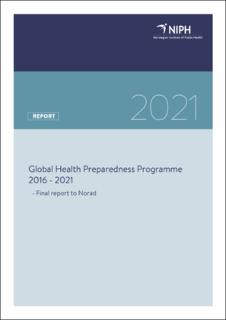| dc.description.abstract | Executive summary
The Norwegian Institute of Public Health (NIPH) established the Global Health Preparedness Programme (GHPP) in 2015 through an agreement with the Ministry of Foreign Affairs. After one and a half years, the GHPP continued with a grant agreement with Norad for a period of five years with a total funding of 46 879 167 Norwegian Kroner (NOK). This report covers the period of the Norad grant from 1 July 2016 to 31 July 2021. GHPP aimed to contribute to the global efforts of strengthening the International Health Regulations (2005) (IHR) core capacities in the partner countries and globally. The mode of work for GHPP was peer-to-peer collaboration between Norway and select low- and middle-income countries (LMIC), Ghana, Malawi, Moldova, and Palestine, and a global component.
The overarching goal of GHPP was to improve the capacity to prevent, detect and respond to public health events of national and international concern in the designated partner countries. That vision was grounded in the following three strategic objectives: 1) to support implementation of IHR core capacities in select partner countries. 2) to contribute to global efforts that enhance capacity and procedures to assist all countries in meeting their obligations under IHR. 3) to strengthen institutional capacity of National Institutes of Public Health, in partner countries, and globally.
Through the GHPP, the NIPH has closely worked with partner countries to strengthen their IHR core capacities through situation analysis and assessment, knowledge development, infrastructure development, exchange of expertise, competence building, and global collaboration to achieve its strategic objectives. The GHPP participated in and conducted various IHR Monitoring and Evaluation Frameworks (IHRMEF) activities including Joint External Evaluation (JEE), Simulation Exercises (SimEx), and After-Action Reviews (AAR). The results from these IHRMEFs were used to develop national implementation plans such as the National Action Plan for Health Security (NAPHS) or its equivalents. These served as implementation templates for GHPP in the countries for all core capacities. Experiences from the partner countries played an important role in the global work of improving health preparedness globally.
The COVID-19 pandemic impacted GHPP principally in two ways: It necessitated a substantial reorganisation of the project when travel was impossible, and all partners shifted from preparedness to response. The pandemic has also acted as the ultimate stress-test for how countries were able to respond. We effectively managed the transition, and all collaborating countries have communicated positive effects of the GHPP on their ability to respond to the pandemic.
The twinning collaboration approach developed during the project proved successful, and it has inspired other public health institutes to adopt a similar model. National ownership is paramount. Long-term commitment is essential; five years is a short time. It takes time to establish mutual trust which is necessary to achieve the goals. Having a strong presence in the countries proved important, either by frequent visits, secondment of a NIPH employee or appointing a local coordinator. For all four countries, a collaboration agreement with an organisation in the country improved implementation. For three of these the WHO country office was a successful choice of partner. The GHPP increased Norway’s international visibility in global health security, and our country experiences from twinning, increased our credibility.
Recommendations
The COVID-19 pandemic has shown the global interdependencies of health security. A health threat anywhere is a health threat everywhere. A strong continued engagement on the global scene and in twinning country collaborations is mutually beneficial for the countries involved and the world at large. NIPH has gained substantial experience from running a complex multicontinental development project and is ready to commit. | |
